“Otherworldly states”: a 1974 portrait by Hujar of his lover Paul Thek, also an artist © The Peter Hujar Archive/Artists Rights Society (ARS), NY
Photography “converts the whole world into a cemetery”, wrote Susan Sontag. “Photographers, connoisseurs of beauty, are also—wittingly or unwittingly—the recording-angels of death.”
Sontag was writing a year before the publication of her book On Photography (1977), expanding on the subject in what remains a key text on the medium and its influence on society. The words appeared in an essay to go with a book by a photographer who was little known beyond his bohemian circle of friends and acquaintances, the demi-monde of New York’s downtown scene in the mid 1970s. It was the only book the photographer published, 11 years before his death from Aids-related illness in 1987, and nearly two decades before his reappraisal as a key American photographer of his generation was cemented with an exhibition at the Stedelijk Museum in Amsterdam.
Palermo Catacombs #6 (Girl with Gloves) is from a series of photographs Hujar took during a visit to the Capuchin Catacombs in Palermo, Sicily, in 1963 © The Peter Hujar Archive/Artists Rights Society (ARS), NY
His posthumous celebration has since moved beyond his status as a cult figure within a time and place and a community of people that have come to be mythologised. And now, perhaps, we are about to hit peak Peter Hujar. The British actor Ben Wishaw is to play the impoverished yet influential photographer in a film biopic based on Linda Rosenkrantz’s book, Peter Hujar’s Day, retelling a recorded conversation in 1974. But before that, Hujar’s 1976 book Portraits in Life and Death is being turned into an exhibition at this year’s Venice Biennale, one of 30 collateral events selected by curator Adriano Pedrosa to fit the theme, Foreigners Everywhere, and its focus on queer and Indigenous figures.
The exhibition will present all 41 photographs from the book at the Chiesa di Santa Maria della Pietà, close to the Doge’s Palace, staged by the Peter Hujar Foundation and curated by Grace Deveney of the Art Institute of Chicago. It will feature two bodies of work: a series of portraits of fellow artists, writers and performers; and photographs taken of the mummified remains vaulted within the Capuchin Catacombs of Palermo, made on a Fulbright scholarship in 1963 in the company of his lover, the artist Paul Thek.
The subjects of the portraits “stand, sit, slouch, mostly lie—and are made to appear to meditate on their own mortality”, wrote Sontag, who also sat for the photographer. “Peter Hujar knows that portraits in life are always, also, portraits in death.” The catacomb pictures clearly made an impact on the writer, because they inspired the setting of a scene in her second novel, Death Kit. “So there’s this really beautiful exchange between [Hujar and Sontag] about photography,” says Deveney. “And that comes through in her writing. And there’s that really iconic portrait of her in the series as well.”
Portraits of Sontag, Thek, Divine, Robert Wilson, Fran Lebowitz, John Waters and others from the Lower East Side arts scene are interspersed with the lesser immortals of the Sicilian catacombs. “What seems to have caught Hujar’s eye was the beautiful and morbid irony of the dead, framed to appear to be as lifelike as possible,” Deveney says. “And then, on the flipside, in a lot of the portraits, both in the book and beyond, you get representations of people—friends and chosen family—displayed in ways that underscore the undercurrent of death and life.
“So many of the figures in the book are reclining or appear to be sleeping or are in these kind of otherworldly states where they appear to be looking beyond or through. And so that tension between finding the most lifelike presentations of death, and then sort of treading into these other states of consciousness within the portraits in the book, is something that comes through really clearly in the juxtaposition.”
“Portraits is important because it was the only book Peter made,” says the art critic Vince Aletti, a friend of Hujar, whose portrait also appears in the book and the Venice exhibition. It is the first time these pictures have been seen together in Europe, and only the second time they have been shown since their debut at Matthew Marks Gallery in New York in 2002. “And because he got Susan Sontag to write an introduction… he continued to make great—and greater—work but he died before most of it was collected for a book or an exhibition.”
Aletti’s writings have played a part in Hujar’s embrace by a wider audience. “Peter never had the recognition he deserved while he was alive, but the work survives and it’s gratifying to know people want to know more about the pictures and the person who made them,” Aletti says.
“I think of Peter’s work as soulful and sensitive without being in the least sentimental. Whether he’s looking at a choppy sea, a dead cat or a celebrity he’s just met, he’s looking as deep as he can, determined to convey something plain and true. Something that still has a palpable presence after all these years.”
• Peter Hujar: Portraits in Life and Death, Chiesa di Santa Maria della Pietà, Riva degli Schiavoni, 20 April-24 November

